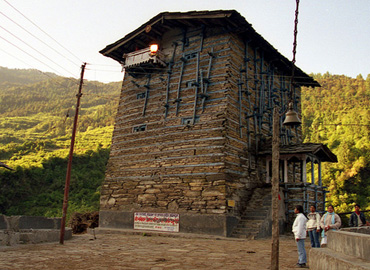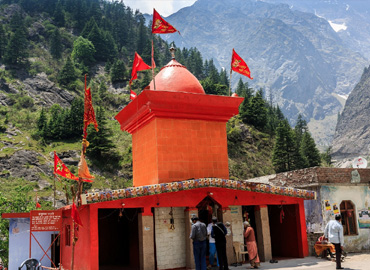





Yamunotri is the source of River Yamuna and is regarded as the seat of Goddess Yamuna. This is the western most shrine in the Garhwal Himalayas, situated at an altitude of 3293 m atop Bandarpunch parvat. Geologically, River Yamuna originates from the Champasar Glacier, which is located below Bandarpunch Mountain at an altitude of 4421 m. Champasar Glacier is about 1 km upstream from the riverbed near Yamunotri Temple but in order to reach the glacier one has to trek for 10 km from the temple. Yamunotri Temple can be reached by 5 km trek from Janki Chatti which is the nearest road point.
According to mythology, Goddess Yamuna is the daughter of Lord Surya (Sun God) and Devi Sandhya and is the sister of Lord Yama. Pilgrims believe that performing holy ablutions in Yamuna offers a painless death in old age.

Surya Kund is one of the most important thermal springs located near the temple of Yamunotri. This hot water spring gets its name from Yamuna River which is considered to be the offspring of Surya, believed to be the father of Yamuna. The presence of this thermal spring bordered by snow-covered mountain peaks adds to the divine significance of the place.
The temperature of Surya Kund is estimated to be around 88'C. Pilgrims prepares Prasad out of potatoes or rice mixed with salt and ties it in a cloth. Then it is dipped into the hot spring where it gets boiled. This Prasad is offered to the temple deity after which the remaining is taken back home by the devotees.

Kharsali is a little village located in the Uttarkashi district of Uttarakhand. Situated at an elevation of 2675 m above the sea level, Kharsali is known as the home of Goddess Yamuna during winters when the Yamunotri Shrine becomes inaccessible due to heavy snowfall.
Kharsali also houses the oldest Shani Dev Temple of India. The idol of Goddess Yamuna is kept at the Shani Dev Temple during the winter season. The temple is a three-storied structure made up of stones, wood and mortar. The temple has withstood several earthquakes and other natural calamities since ages. It is believed that the temple was built by the Pandavas.

Saptarishi Kund is the original source of Yamuna River fed by Champasar Glacier situated in the upper parts of the massif created by Bandarpunch Mountain. It is an ideal place for trekking near Yamunotri for 2-3 days.
Saptrishi Kund is about a half km in diameter, and its water is dark blue in color, The water of the nearby glaciers gathers in this lake. On the banks of Saptrishi Kund Lake, there are naturally created slate stones. The rare Brahma Lotus grows here. It is believed that seven great Rishis Kasyapa, Atri, Bharadwaj, Viswamitra, Gautama, Jamadagni, and Vasistha performed penance at Saptrishi Lake.

Janki Chatti is perched at an elevation of about 2650 m above the sea level and is famous for its many hot water springs. Taking a dip in the hot water from these springs is considered very sacred, before visiting the Yamunotri. This area encompasses the last village in the region and the pilgrims are provided with moderate accommodation facilities here.
Janki Chatti town is very famous among tourists who travel to the region of Yamunotri during Char Dham Yatra. Previously the starting point of the trek to reach Yamunotri was Hanuman Chatti but now jeeps are available up to Janki Chatti. Ponies and palanquins are available at Janki Chatti.

Hanuman Chatti is a small hamlet on the way to Yamunotri in Uttarkashi district of Uttarakhand. Located at the confluence of the Hanuman Ganga and Yamuna Rivers, Hanuman Chatti used to be a halting place for pilgrims during their Char Dham Yatra. Hanuman Chatti lies at an altitude of 2400 m and it is a serene place offering good accommodation facilities.
There are many small temples in the region, the most noteworthy temple is the one dedicated to Hanuman. Within the interiors of the temple there is an impressive image of Lord Hanuman carrying a mountain. To the left of the temple there is a Samadhi of Himalaya Giri, a saint who lived and meditated in Hanuman Chatti. On top of the shrine there is a Shiva Linga.